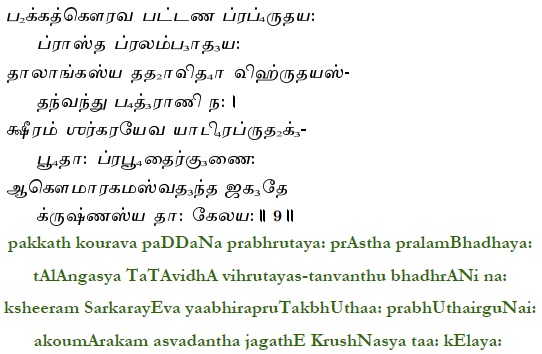The key prayer housed in this slOkam is: “tAlAnkasya vihrutaya: na: bhadhrANi tanvanthu” ( May the sports of BalarAma shower auspiciousness on us all).
MEANING:
Our Lord took on an avathAram as the elder of Krishna. This amsa avathAram is known as BalarAmAvathAram. In this avathAram, BalarAman was never separated from His younger brother, KaNNan, even for a short time. He “protected” his younger brother all the time. BalarAma had the plough as His weapon and palm tree as the emblem in His flag. The Kourava kings had the city of HasthinApuram as their capitol. Once; the angry BalarAman pulled the whole city of HasthinApuram with His plough and dumped it in the river Yamuna. He killed asurans like Pralambhan, who came to Gokulam to harm KrishNan during His younger days. The leelAs of BalarAma and KaNNan have to be tasted independently. When the two are bended together for full anubhavam, the combined Leelais have the enhancement of sweetness of the milk by addition of Sugar to it. May the delectable leelAs of BalarAma shower us with MangaLams!
COMMENTS:
Sri Anbil GopAlAcchAr Swamy’s comments: Like ParasurAmAvathAram, the BalarAmAvathAram is that of a Seeshan (The liege of the Lord). KrishNaavathAram and RaamvathAram are those of the Seshi ( The Lord). Both are “Karshakars” or the pullers. BalarAman pulled HasthinApuram into the river and cast it away in the river YamunA. KrishNa pulled the mortar and brought down the two YamaLa trees in His garden. The relationship between KaNNan and BalarAman is mutually reinforcing to increase the sweetness like adding Sugar to milk. Seshi is the milk and Seshan is the Sugar. Their union is mutually rewarding. Seshan makes the Seshi sweeter by joining the Seshi. “SEsha-Seshi relationship, togetherness and conjunction –all make for greater delectability — as sugar admixed with milk”. BalarAman’s other name is Balabhadhran. In this context, Swamy Desikan prays for Bhadhram: “TaaLangasya vihrutaya: na: bhadhrANi tanvanthu”.
Commentary by: Sri Oppiliappan Koil VaradAchAri Sadagopan
to be continued…










